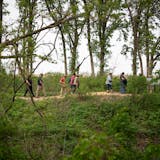A key piece of groundwork starts Monday to begin connecting one of Minnesota's most-visited parks with one of its original rail trails.
The first phase of establishing a connector trail of more than 20 miles from Itasca State Park to Park Rapids and the Heartland State Trail will begin with a new tunnel under Hwy. 71, just south of Hwy. 200 near the park's east entrance. A section of trail will run from the box culvert west to the state park entrance. The project, paid for with $2 million in bonding money approved by the Legislature, is expected to be finished in late September.
When the final phases of trail-building continue is unknown and dependent on funding, among other factors. But plans call for phase two to pick up where builders left off near the park with 13 miles of trail headed east to Emmaville, the bulk of it on Hubbard County land, followed by an 8-mile segment from Emmaville to the Heartland trail.
The Heartland, a multi-use trail that currently runs 49 miles from Park Rapids to Cass Lake, is one of the first rail trails in the country, according to the Rails-to-Trails Conservancy. Itasca State Park, home to the headwaters of the Mississippi River, draws more than 500,000 people yearly, according to the Department of Natural Resources.
"Having this trail connect to Itasca State Park is important, as it's Minnesota's oldest and one of the most-visited state parks," said Sara Joy Bernhow, a Parks and Trails spokesperson.
While visitors seek out the headwaters, the park has become a biking destination, too, Bernhow added. There are 16 miles of paved bike trails. "Connecting to the Heartland State Trail will make Itasca State Park even more of a draw for biking enthusiasts."
The trail project has involved years of planning, and like similar efforts is a complex land management mixture of easements, engineering and environmental review. For example, trees were felled last winter to accommodate phase one because of concerns about bat nesting this summer. Plus, there have been wetland protections to address, said DNR parks and trails area manager Dave Schotzko in Bemidji.
"The hardest thing is getting started," said Schotzko. "Itasca is a big deal. It is all working out."
![Three weeks ago, Octavio Rodriguez switched from making transmission parts to casting parts for hospital bed brake assemblies at Twin City Die Castings. ] GLEN STUBBE • glen.stubbe@startribune.com Thursday, April 9, 2020 How employee-owned Twin City Die Casting, which just laid off 40 production workers of its 250 employees in what was supposed to be a good year, is trying to accelerate its pivot to growing medical parts business for ventilators, hospital beds, etc as it copes with instan](https://arc.stimg.co/startribunemedia/WNZYKGTZ5IYMUCO3KI5TR3N7WI.jpg?&w=80&ar=1:1&fit=crop)
djoles@startribune.com As boaters flock to Minnesota lakes and rivers this holiday weekend for the unofficial kick-off to the boating season, they'll face more inspections in and out of the water as local cities and counties ramp up their work to stop the spread of invasive species. Across the metro, more boat accesses will be staffed by watercraft inspectors thanks to $10 million funneled to county government programs this year, up from $4.5 million the state allocated last year. ORG XMIT: MIN1505222156290209 ORG XMIT: MIN1506021218440580](https://arc.stimg.co/startribunemedia/34QSKO44B2XKVNUZCO5SLJQSLY.jpg?&w=80&ar=1:1&fit=crop)

